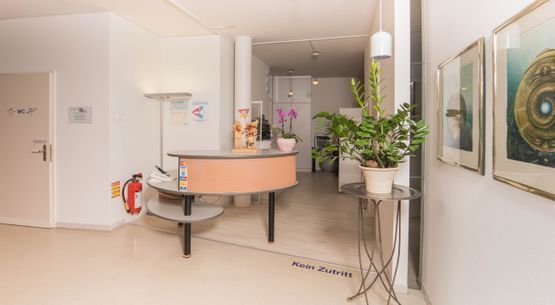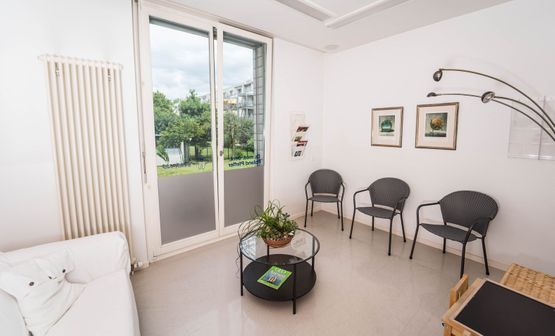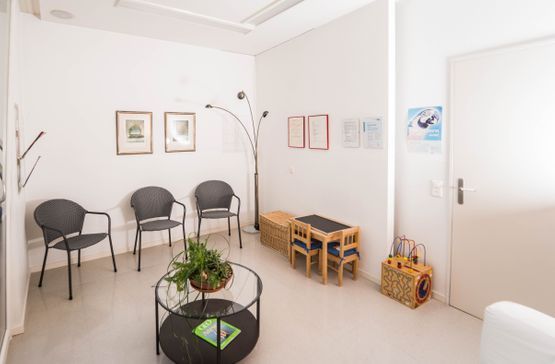Useful information

“It doesn’t always have to be an implant”
Dental prostheses are generally divided into two groups: fixed prostheses and removable prostheses.
“Fixed” means the prosthetic reconstruction is secured in place, with the patient being unable to remove the prosthesis. This would usually be a cemented crown or bridge (or, less frequently, a screw-retained variant) supported solely by the abutment teeth or implants.
Bonded partial crowns (dental facets or veneers) are also available for the anterior region of the mouth. This type of dental prosthesis is used to correct a tooth’s colour or shape and is gentle on the tooth’s substance. Front tooth crowns are indicated to remedy substantial defects or correct the position of a tooth. Posterior tooth crowns are used to correct major defects or for major corrections to the full row of teeth.
Removable dental prostheses come in many variations – from a total prosthesis to a partial one. The device is anchored to individual abutments and fitted with sufficient prosthetic teeth to fill the gap in the section of the jaw left by the missing teeth. This section of missing teeth is usually fitted with a pinkish, gum-like plastic base – also known as a saddle – onto which the prosthetic teeth are mounted.
Full prostheses sit on the jaw’s mucous membrane, with the upper prosthesis also covering the palate. The prosthesis is held in place by the suction generated between the prosthesis base and the oral mucosa. In certain cases, a few individual tooth roots or implants with a press-stud attachment can help improve the hold of the prosthesis (especially in the lower jaw).
There are many variants of partial prosthesis available. The prosthesis is anchored using either simple wire clamps, high-quality cast clamps, press studs or crown/special double-crown attachments. The prices vary greatly, depending on whether you opt for clamps or crowns to anchor the partial prosthesis.
Bleaching
Bleaching is used to treat discoloured teeth. Tooth discolouration is caused by certain eating habits (e.g. drinking tea or coffee), smoking and taking medication. In the industry, a distinction is made between external and internal discolouration (the latter can often be seen in teeth treated for nerve damage).
We always perform a professional teeth cleaning before any treatment. It is also essential to determine what type of discolouration (external or internal) needs to be treated. Another factor to remember is that the colour of existing fillings will not change, so these may have to be replaced after bleaching.
There are two bleaching methods when it comes to external discolouration: home bleaching and in-office bleaching.
For at-home bleaching, a form-fitting bleaching tray (or retainer) is created with which the bleaching agent is applied to the teeth. There are two types of bleaching agent, which determine whether the retainer is to be worn during the day or at night. The retainer can be used multiple times – even over a period of years, providing the teeth are not subject to any major changes (fillings, crowns, etc.).
In-office bleaching is performed at the dental clinic, with the bleaching agent for external discolourations being applied to the teeth after insulating the gums against the agent. The treatment takes around one hour.
When dealing with internal discolouration, the tooth treated for nerve damage is opened and the bleaching agent is applied inside the tooth via an inlay and sealed with a temporary filling. The bleaching agent is removed after a few days, and a permanent filling is inserted in a colour that matches the tooth.


Treatment of patients on social welfare
As people are free to choose between medical professionals in Switzerland, patients on social welfare or receiving supplementary benefits are eligible for treatment in private practices. However, large-scale treatments require precise planning and official approval that the treatment costs will be covered.
The government’s guidelines on social contributions for treatments requiring official approval are formulated to ensure the treatment is effective, expedient and economical (in accordance with the provisions of VKZS, the Association of Swiss Cantonal Dentists). This means that prosthetic reconstructions of permanent solutions involving a bridge or implants will not be authorised for reasons of cost. Treatments intended solely for aesthetic purposes will likewise not be authorised.
Obligation for dental practices to specify prices
Service providers in the field of dentistry have been obliged to specify their prices since 1 June 2004. The price of dental services is calculated according to the number of “tariff points” per stage of work (primarily based on time spent) and the actual tariff point value. The tariff point value varies from practice to practice and is determined based on the practice’s economic criteria (equipment, financing, personnel costs, qualifications, etc.).
The standard tariff applied by the SSO was revised on 1 January 2018 and is now referred to as the “Dentotar”. The basic tariff point value is now CHF 1 (previously CHF 3.10). The tariff point was adjusted to reflect this (a multiplication of around 3.486 compared with previously).
Under this new tariff system, inflation since 1 April 1994 has been partially compensated for – services have become around 12.45% more expensive (however, actual inflation is closer to 18%). The dental tariff catalogue is extremely comprehensive and contains more than 400 individual services. Pfeffer Dental Practice provides its treatments based on the following tariffs:
- Private tariff CHF 1.09 (as of 1 January 2018)
- Pensioners, welfare recipients, recipients of disability benefits CHF 1 (as of 1 January 2018)
- Schoolchildren, apprentices, students, welfare recipients CHF 1 (as of 1 January 2018)
- Recipients of accident insurance CHF 1 (as of 1 January 2018)
- Recipients of medical insurance CHF 3.10 (old tariff from 1994)
The maximum permitted private tariff is CHF 1.60.
For more exact prices, you can request a cost estimate. However, a full examination will have to be made and a report prepared.
If you have any questions or would like more information, our team will be happy to help.


